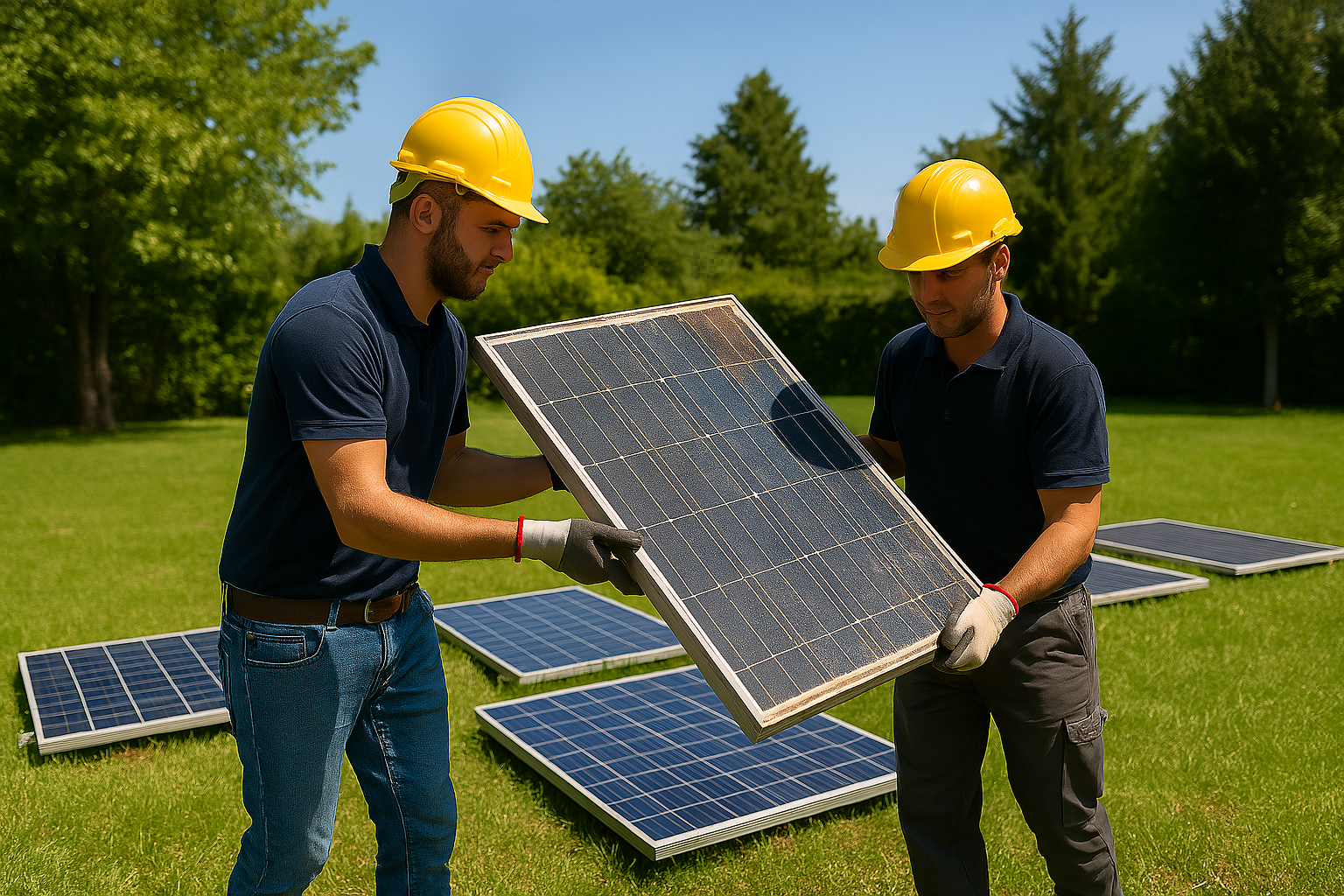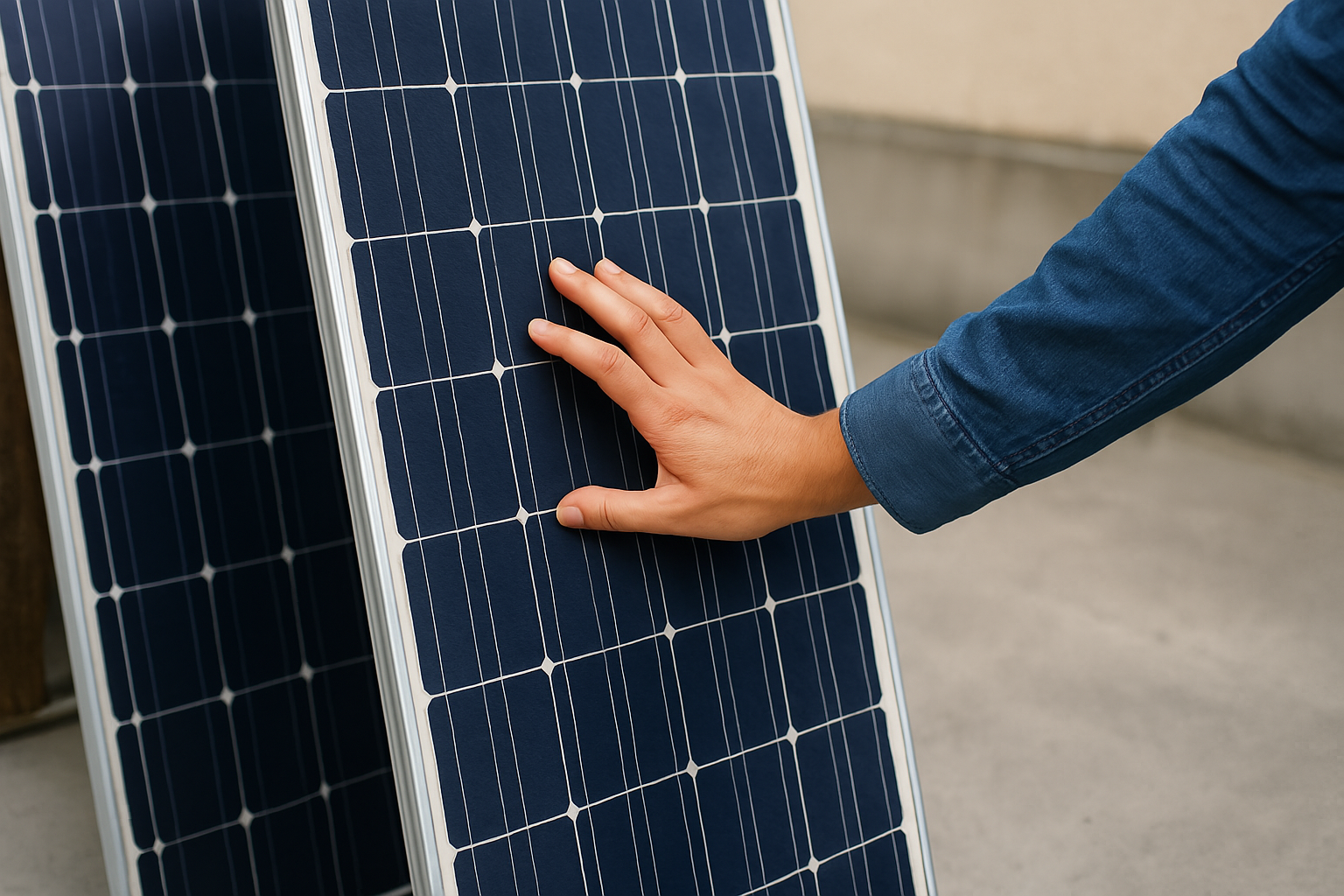Published on 09 May 2024
Photovoltaic Repowering: What It Is, When It's Worthwhile, and What to Do with Used Panels

Has your photovoltaic system been in operation for several years and no longer produces as it once did? It might be time to consider repowering.
In recent years, many companies and private individuals have been evaluating the possibility of upgrading their existing photovoltaic systems to improve efficiency, take advantage of more modern technologies, and achieve a better return on investment. This process is known as photovoltaic repowering and today, with rising energy demand and a second-hand market that is increasingly mature, it represents a strategic choice.
In this article, we will look at what repowering is, when it is worthwhile, how much it can cost, and what to do with the photovoltaic panels that are decommissioned.

What is photovoltaic repowering?
Photovoltaic repowering is an intervention that improves the performance of an existing system by replacing certain components, such as panels or the inverter, with more modern and efficient versions.
Unlike revamping, which mainly focuses on maintenance or repairing the system, repowering aims to concretely increase energy production.
This process is particularly useful for systems installed more than ten years ago: technology has evolved, panel efficiency has increased, and upgrading is now more worthwhile than ever.
Repowering does not mean starting everything from scratch, but rather making the most of what is already there, improving the yield, reliability, and sustainability of the system.
And what about revamping?
It is often confused with repowering, but it has a different goal. Photovoltaic revamping focuses on compliance, complete refurbishment, or maintenance of the system, without necessarily increasing production. It may include minor replacements, restorations, or technical updates to maintain eligibility for incentive tariffs.
When is repowering worthwhile?
Photovoltaic repowering is especially worthwhile when the system is more than 10-12 years old and no longer produces as it should. If you have noticed a clear decline in production, or if you are receiving higher electricity bills despite the system being active, you may be at the right moment to intervene.
Here are some useful signs to understand if repowering is suitable for you:
Constant annual decrease in production
Outdated or out-of-warranty inverter or panels
Difficulty in finding spare parts
New objectives, such as increasing self-consumption or installing a storage system
End of incentives or regulatory changes that allow upgrades
It is also worth considering repowering if you are thinking of selling the system or the decommissioned panels: thanks to the second-hand market, you can recover value and reduce the cost of the intervention.
In addition to the age of the system, there are several causes that may lead to a decline in performance over time:
the natural degradation of panels,
partial shading issues never resolved,
mechanical damage or malfunctions not visible to the naked eye,
an inverter no longer able to operate optimally.
In these cases, a well-planned repowering intervention can restore the system to much higher levels of efficiency, even without a complete replacement.
Advantages of photovoltaic repowering
Choosing repowering means giving new energy to your system without having to rebuild it from scratch.
Here are the main benefits of this intervention:
Higher energy production
The latest generation panels have much higher efficiency compared to those installed 10 or 15 years ago. With repowering, you can increase yield by as much as 20–30%, with the same amount of space occupied.
Faster return on investment
By improving production, you recover the costs incurred more quickly. And if you sell the replaced panels through the second-hand market, you further reduce expenses.
Updated and reliable technology
Modern systems are more efficient, safer, and easier to monitor thanks to new remote management and control systems.
Added value to the system
An upgraded system is also more attractive in terms of transfer, property sale, or energy sharing.
Sustainable choice
Carrying out repowering, especially if old panels are recovered or reintroduced into circulation, reduces waste and extends the life cycle of materials.
Are you thinking of selling your used panels?
Go to KTSHow much does photovoltaic repowering cost?
The cost of a repowering intervention varies depending on several factors, such as:
the size of the system,
the number of components to be replaced (panels, inverter, cabling),
the technology chosen for the upgrade.
In general, for a residential system, the cost can start from €1000-2000, while for larger systems it can exceed €10000.
But be careful: upgrading the system does not always mean starting from scratch.
Many components can be reused, and decommissioned panels may still have value.
By selling them through a marketplace like KTS, you can recover part of the investment and reduce the environmental impact of the intervention.
The best way to get an accurate idea? Request a technical evaluation of the current system. In many cases, repowering turns out to be more affordable than you might think.
How a repowering intervention works: the main steps
Every repowering intervention begins with a thorough technical analysis of the existing system. Active components, their condition, residual efficiency, and any critical issues are evaluated.
Based on the results, it is defined:
which panels to replace;
whether it is necessary to upgrade the inverter or other components;
how to intervene on the system to increase yield in compliance with current regulations.
Finally, the installation of the new components and the management of the decommissioned panels are planned. In this last phase, with KTS it is possible to evaluate and sell reusable panels, reducing waste and costs.
What to do with decommissioned photovoltaic panels?
After a repowering intervention, you may find yourself with panels that are still functional but no longer suitable for the upgraded system. What happens to them?
The answer does not necessarily have to be disposal.
There is an increasingly active second-hand photovoltaic market, where these panels can find a new life. Small systems, off-grid installations, or agricultural and industrial facilities can still derive value from them.
And this is where KTS comes in. We are the first marketplace dedicated exclusively to the buying and selling of used solar panels, selected and verified.
With KTS you can:
Evaluate and put your decommissioned panels up for sale
Find interested buyers
Help reduce waste and extend the lifecycle of materials
A smart, sustainable choice, perfectly in line with the spirit of repowering: doing more with what already exists.

Regulations and obligations for photovoltaic repowering
For incentivized systems, it is essential to comply with the regulations of the GSE (Gestore dei Servizi Energetici – Energy Services Operator). In general, modifications that alter the original configuration of the system require mandatory communication to the GSE within 60 days of the change. For example, increasing the power of the system or replacing main components such as inverters and modules are interventions that must be reported to avoid penalties or the loss of incentives.
From a regulatory perspective, revamping and repowering interventions are therefore regulated by the GSE, which sets out the guidelines for maintaining incentives and the procedures for communicating technical modifications.
Are you considering photovoltaic revamping or repowering?
The dismantling and management of used photovoltaic panels represent a significant cost, which can be offset if you decide to sell them instead of disposing of them.
If you are thinking of restoring your system to its original performance through revamping, or of increasing its power with photovoltaic repowering, on KeepTheSun you can sell your used panels. Register, publish your ad for free, and you will be contacted directly by interested buyers. Start giving value to your used panels!
If instead you want to renew a large industrial system, contact us: we will connect you with buyers interested in your used panels.
Do you want to sell your panels?
Sell them on KTSFrequently asked questions about photovoltaic repowering
What is the difference between revamping and repowering?
Revamping is a maintenance or restoration intervention on the system, useful for solving faults or ensuring regulatory compliance.
Repowering, on the other hand, aims to improve performance by replacing key components to increase production.
Does the GSE accept modifications to incentivized systems?
Yes, but under specific conditions. The GSE requires that modifications do not alter the incentivized power or the authorized regime. Before proceeding, it is advisable to carry out a technical and regulatory check.
How long does it take to recover the investment?
It depends on the system. In many cases, thanks to increased production and the possibility of selling decommissioned panels, payback occurs within a few years.
Can repowering also be carried out on small residential systems?
Absolutely yes. It is not an intervention reserved only for large installations. Even systems of 3 or 6 kW can benefit from an upgrade.
What happens to the panels that are replaced?
If they are still functional, they can be reused. Thanks to KTS, it is possible to sell them to those looking for quality second-hand panels for other projects. If they are no longer usable, they must be disposed of according to WEEE regulations.